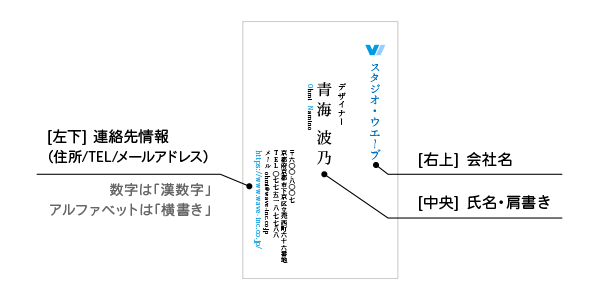
Business cards are a must-have, especially when doing business in Japan or with any Japanese person. The exchange of business cards (meishi koukan 名刺交換)) is a tradition in Japanese business and it is essential to know the inner working. Sure, you need to have some cards with you, however, the first step is to always have printed cards
So what do you have to include on it, or not include? What are the basics and common sense concerning business cards?
- YOUR FULL NAME:
- On the Japanese side: write your name in katakana
- This will allow people to pronounce your name correctly
- Company/Organization Name & Logo
- This give you more credibility, be more trustworthy, and help people recognize your card more easily
- Department & Section:
- if needed: add your department and section names in a smaller font
- Title:
- Written on the upper left side of your name in horizontal writing
- Written on the upper right side of your name in vertical writing.
- This is useful when trading since other businessmen will know who makes the decision
- Company Location:
- write the complete address, with the postal code and name of the prefecture
- A small map can be added
- Business Hours and Regular Holidays:
- it is usually for store business cards, but it is possible to put your office hours.
- Phone Number:
- Use a phone number you think are necessary
- (the representative’s number and your business phone number, for example).
- Email Address, Website URL, SNS accounts:
- if you have a website, a blog, or important social media channels, indicate it on your card.
- An email address (personal and/or of your department/section) is also important
- Photo of Yourself:
- people will better remember you if you add a photo
- they will possibly meet many other businessmen and will not remember everyone’s face.
- Company Slogan:
- if you use Chinese characters and if some of them are hard to read, add the furigana (Japanese reading aid)
- QR Code:
- For example, you can add a QR code for your website or product. This allows easy access to your company’s website information
- Short Introduction:
- This can be your past achievements, your philosophy, your service, or maybe even a hobby.
- Product Name:
- if you release a new product and come to Japan to sell it, you can put its name as well as QR Code and/or a picture of it.
- You can create sorts of ‘limited edition’ cards, for a special event for example.
- Main Business Partner Name:
- Show that you have connections with other businesses, especially if it’s a well-known business in Japan
- Card Size:
- your card must fit in a business cardholder.
- Japanese business cards are 55x91mm or 91x55mm (the card should not be folded).
- If you want to include a lot of information, you can think about twofold or threefold business cards.
- If you want to stand out, you can still print bigger cards – but they will not fit in a regular cardholder
- Front Size:
- at least 5.5 pt. Anything smaller will be hard to read and can leave a negative impression.
- Back:
- An English version can be on the back. If you do so, remember to show the side with the correct language facing up.
- Design:
- the more design your card, the better the impression.
- However, do not overdesign your card

Horizontal or Vertical Layout?
| Horizontal
Since it is easier to read URLs and email addresses horizontally, horizontal cards have become mainstream. It is also easier to add the Japanese 7-digit postal codes and, it will enable you to have a uniform font.
The first line should contain your company name, the second your name and title and the third should contain the rest (usually on the left side).







